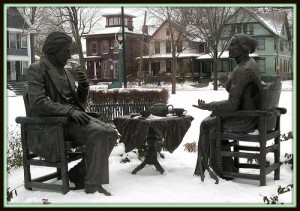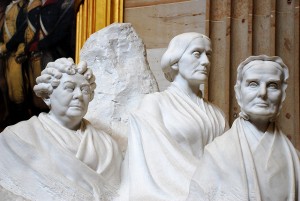By Briana Ward.
 Susan B. Anthony (1820 – 1906), grew up in a Massachusetts a Quaker family with activist traditions. Growing up in this type of environment, Anthony developed a strong sense of justice early in life. When she got older, she began going to temperance meetings. Although she was unable to voice her thoughts and opinions, she still attended the meetings. She was disturbed by not being able to insert her opinions regarding the temperance movement, so she joined the women’s suffrage movement. Women’s suffrage became an important part in her life.
Susan B. Anthony (1820 – 1906), grew up in a Massachusetts a Quaker family with activist traditions. Growing up in this type of environment, Anthony developed a strong sense of justice early in life. When she got older, she began going to temperance meetings. Although she was unable to voice her thoughts and opinions, she still attended the meetings. She was disturbed by not being able to insert her opinions regarding the temperance movement, so she joined the women’s suffrage movement. Women’s suffrage became an important part in her life.

She campaigned against abolition of slavery,the right for women to own their own property and retain their earnings, and she advocated for women’s labor organizations. Persuading the University of Rochester to admit women was an enormous milestone. Here is a list of a few amazing things she accomplished as a labor activist, suffragist, abolitionist, and temperance worker (from susanbanthonyhouse.org):
- 1848: Anthony made her first public speech at a Daughters of Temperance supper.
- 1863: Anthony and Elizabeth Cady Stanton organized a Women’s National Loyal League to support and petition for the Thirteenth Amendment outlawing slavery. They went on to campaign for full citizenship for women and people of any race, including the right to vote, in the Fourteenth and Fifteenth Amendments.

- 1866: Anthony and Stanton founded the American Equal Rights Association. In 1868, they began publishing the newspaper, The Revolution, in Rochester, with the masthead “Men their rights, and nothing more; women, their rights, and nothing less,” and the aim of establishing “justice for all.” The Revolution also advocated an eight-hour work day and equal pay for equal work. It promoted a policy of purchasing American-made goods and encouraging immigration to rebuild the South and settle the entire country. Publishing The Revolution in New York brought her in contact with women in the printing trades.
- 1870: Anthony formed and was elected president of the Workingwomen’s Central Association. The WCA drew up reports on working conditions and provided educational opportunities for working women. Anthony encouraged a cooperative workshop founded by the Sewing Machine Operators Union and boosted the newly-formed women typesetters’ union in The Revolution. Anthony tried to establish trade schools for women printers. When printers in New York went on strike, she urged employers to hire women instead, believing this would show that they could do the job as well as men, and therefore prove that they deserved equal pay. At the 1869 National Labor Union Congress, the men’s Typographical Union accused her of strike- breaking and running a non-union shop at The Revolution, and called her an enemy of labor.